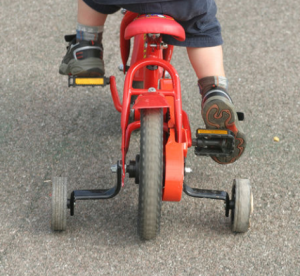Riding the Bike


As a parent, you have probably experienced the fun and excitement of teaching your son or daughter to ride a bike. A new bike, with just two wheels, marks a growth stage for kids. Kids are validated for getting bigger. It is a sign of progress. As a parent you know that there is going to be some accidents, falls and bruised knees. So in order to ensure that the fun and excitement lasts as long as possible the new bike comes with training wheels.
The training wheels are attached to the rear axle, and the wheels themselves do not touch the ground unless the bike rocks to the left or to the right. The beauty of the training wheels is that your child can sit on the bike, and start pedaling from the beginning. The alternative is that you hold the bike, your child starts to pedal, all goes well until the pedaling slows down and the inevitable crash occurs.
The capital markets have exhibited many ups and downs over the last 2 years. 2008 was not an up and down, it was just a down! Coming off the huge down turn, the market has, by and large, been in a trading range. Trading range simply means that the market seems to go up to a certain level and then right back down to a previous low point. And this pattern is repeated many times. It is frustrating because it seems to derail any real progress for the market or for your portfolio. And the question becomes: why is this happening? If you think of the capital markets as the bike, and government policy as the training wheels, I think some insight can be generated. It is generally assumed that corporations are profitable. The profitability may have been achieved at the expense of jobs, nevertheless a very high percentage of the S&P listed corporations are very profitable. An indication of profitability is the willingness for many companies to raise their dividend. Cisco just raised its dividend. GE raised its dividend. Corporations know that in order to reward shareholders during times of modest growth, dividends build commitment. So, if companies are profitable, then why are we in a period of low growth? Why are we in a trading range? The answer lies in understanding the impact of government policy. The year 2009 began a turnaround based simply on the fact that the U.S. government starting rolling out guarantees and fixes that created confidence and stabilized the markets. The corporate assumption – a big assumption – is that government would do what was required to keep the economy from going backwards. Consumer demand can only survive in a positive economy. So companies assume that the government will do its job and as a result they will continue to be profitable as well.
The bike metaphor works as follows: the bike = corporations/corporate profits, the training wheels = government policy. We are in a recovery. Companies still need the training wheels.
Examples of negative government policy and hence weak training wheels: 1. Bad news out of Europe, 2. Downgrading of U.S. debt security. 3. Out of control U.S debt. 4. No action by congress on a budget.
Visualize a time when the economy moves forward on its own. No government support is needed. The training wheels come off. Corporations have figured out how fast to peddle so they stay upright. Frustrating trading range goes away.
| Check out other articles | |
| Robin hood and the objectification of risk | Splitting the risk |
| Sell in may and go away | |
| Seasons of the stock market | |
| Sector rotation | |